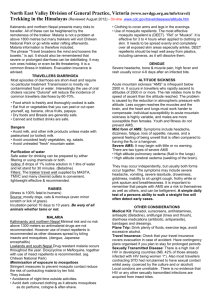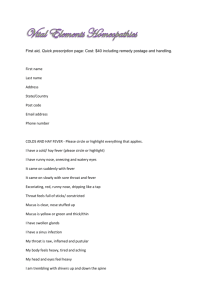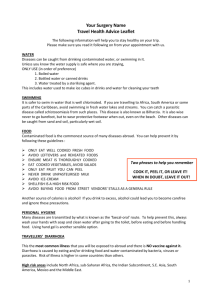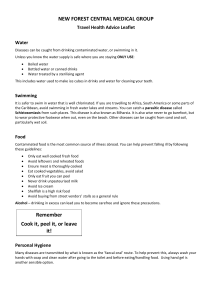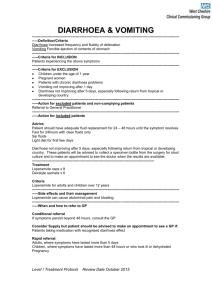Dengue & Dengue haemorrhagic fever
advertisement
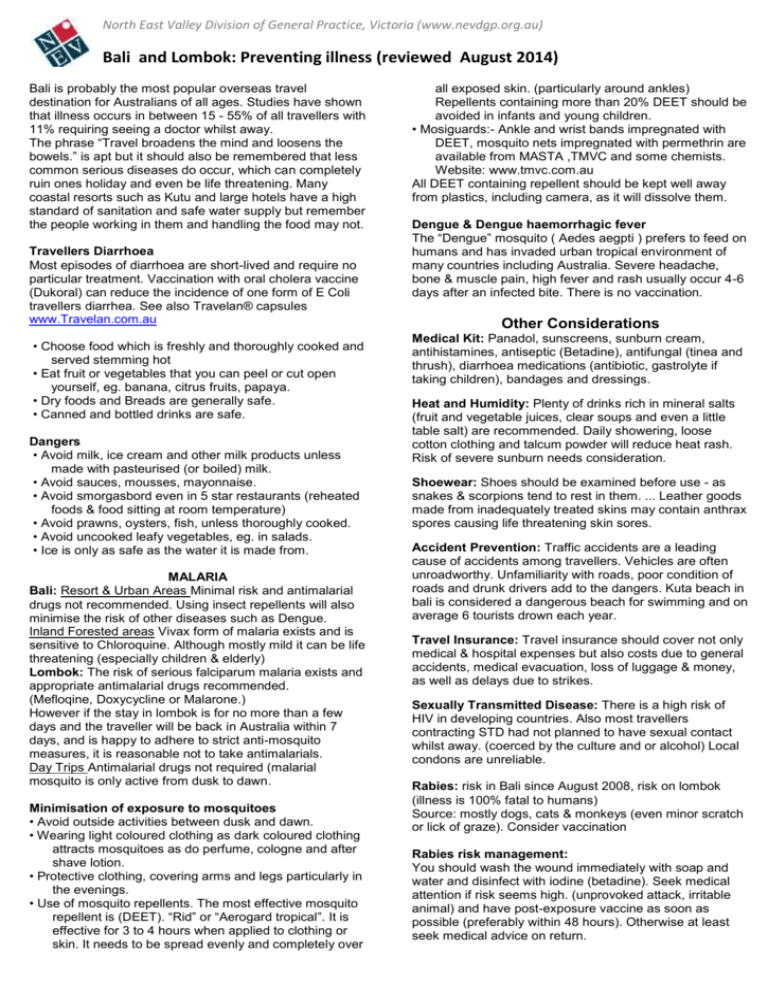
North East Valley Division of General Practice, Victoria (www.nevdgp.org.au) Bali and Lombok: Preventing illness (reviewed August 2014) Bali is probably the most popular overseas travel destination for Australians of all ages. Studies have shown that illness occurs in between 15 - 55% of all travellers with 11% requiring seeing a doctor whilst away. The phrase “Travel broadens the mind and loosens the bowels.” is apt but it should also be remembered that less common serious diseases do occur, which can completely ruin ones holiday and even be life threatening. Many coastal resorts such as Kutu and large hotels have a high standard of sanitation and safe water supply but remember the people working in them and handling the food may not. Travellers Diarrhoea Most episodes of diarrhoea are short-lived and require no particular treatment. Vaccination with oral cholera vaccine (Dukoral) can reduce the incidence of one form of E Coli travellers diarrhea. See also Travelan® capsules www.Travelan.com.au • Choose food which is freshly and thoroughly cooked and served stemming hot • Eat fruit or vegetables that you can peel or cut open yourself, eg. banana, citrus fruits, papaya. • Dry foods and Breads are generally safe. • Canned and bottled drinks are safe. Dangers • Avoid milk, ice cream and other milk products unless made with pasteurised (or boiled) milk. • Avoid sauces, mousses, mayonnaise. • Avoid smorgasbord even in 5 star restaurants (reheated foods & food sitting at room temperature) • Avoid prawns, oysters, fish, unless thoroughly cooked. • Avoid uncooked leafy vegetables, eg. in salads. • Ice is only as safe as the water it is made from. MALARIA Bali: Resort & Urban Areas Minimal risk and antimalarial drugs not recommended. Using insect repellents will also minimise the risk of other diseases such as Dengue. Inland Forested areas Vivax form of malaria exists and is sensitive to Chloroquine. Although mostly mild it can be life threatening (especially children & elderly) Lombok: The risk of serious falciparum malaria exists and appropriate antimalarial drugs recommended. (Mefloqine, Doxycycline or Malarone.) However if the stay in lombok is for no more than a few days and the traveller will be back in Australia within 7 days, and is happy to adhere to strict anti-mosquito measures, it is reasonable not to take antimalarials. Day Trips Antimalarial drugs not required (malarial mosquito is only active from dusk to dawn. Minimisation of exposure to mosquitoes • Avoid outside activities between dusk and dawn. • Wearing light coloured clothing as dark coloured clothing attracts mosquitoes as do perfume, cologne and after shave lotion. • Protective clothing, covering arms and legs particularly in the evenings. • Use of mosquito repellents. The most effective mosquito repellent is (DEET). “Rid” or “Aerogard tropical”. It is effective for 3 to 4 hours when applied to clothing or skin. It needs to be spread evenly and completely over all exposed skin. (particularly around ankles) Repellents containing more than 20% DEET should be avoided in infants and young children. • Mosiguards:- Ankle and wrist bands impregnated with DEET, mosquito nets impregnated with permethrin are available from MASTA ,TMVC and some chemists. Website: www.tmvc.com.au All DEET containing repellent should be kept well away from plastics, including camera, as it will dissolve them. Dengue & Dengue haemorrhagic fever The “Dengue” mosquito ( Aedes aegpti ) prefers to feed on humans and has invaded urban tropical environment of many countries including Australia. Severe headache, bone & muscle pain, high fever and rash usually occur 4-6 days after an infected bite. There is no vaccination. Other Considerations Medical Kit: Panadol, sunscreens, sunburn cream, antihistamines, antiseptic (Betadine), antifungal (tinea and thrush), diarrhoea medications (antibiotic, gastrolyte if taking children), bandages and dressings. Heat and Humidity: Plenty of drinks rich in mineral salts (fruit and vegetable juices, clear soups and even a little table salt) are recommended. Daily showering, loose cotton clothing and talcum powder will reduce heat rash. Risk of severe sunburn needs consideration. Shoewear: Shoes should be examined before use - as snakes & scorpions tend to rest in them. ... Leather goods made from inadequately treated skins may contain anthrax spores causing life threatening skin sores. Accident Prevention: Traffic accidents are a leading cause of accidents among travellers. Vehicles are often unroadworthy. Unfamiliarity with roads, poor condition of roads and drunk drivers add to the dangers. Kuta beach in bali is considered a dangerous beach for swimming and on average 6 tourists drown each year. Travel Insurance: Travel insurance should cover not only medical & hospital expenses but also costs due to general accidents, medical evacuation, loss of luggage & money, as well as delays due to strikes. Sexually Transmitted Disease: There is a high risk of HIV in developing countries. Also most travellers contracting STD had not planned to have sexual contact whilst away. (coerced by the culture and or alcohol) Local condons are unreliable. Rabies: risk in Bali since August 2008, risk on lombok (illness is 100% fatal to humans) Source: mostly dogs, cats & monkeys (even minor scratch or lick of graze). Consider vaccination Rabies risk management: You should wash the wound immediately with soap and water and disinfect with iodine (betadine). Seek medical attention if risk seems high. (unprovoked attack, irritable animal) and have post-exposure vaccine as soon as possible (preferably within 48 hours). Otherwise at least seek medical advice on return. Bali & Lombok: Treatment information (revised August 2014) MANAGEMENT OF DIARRHOEA Because diarrhoea is so common it is important to be aware of how to manage it if prevention fails. • Fluids - Almost any beverage coupled with a source of salt (eg., salted crackers) suffices. Bottled or canned beverages, tea, broth, foods such as rice, bananas, papaya (papaw), potatoes & dry biscuits are tolerated best. Mineral water flavoured with 5% fruit juice is close to ideal. • Antimotility drugs (‘stoppers’). Since most diarrhoeal illnesses last only a few days, these drugs may be very helpful in relieving diarrhoea and cramps. Do not use if high fever or blood in motions. Do not use in children under 6, and be cautious in children under 12. Adult Dosage: loperamide (Imodium) -2 capsules (each 2 mg) followed by 1 cap after each unformed stool. (maximum 8 caps per day.) • Antibiotics. Diarrhoea with high fever, distressing symptoms or blood in motions; A single dose of two Norfloxacin 400mg tablets should be effective. If response is not dramatic after 12 hours continue 1 tab twice a day for a further 3 days. An alternative is azithromycin & can be used in children & pregnancy. • Prolonged diarrhoea (>10 days) and without fever a bowel parasite “giardiasis” is the commonest cause. The best treatment is tinidasole (Fasigyn) - 4 x 500mg tablets (2g) in a single dose. Metronidazole 400mg three times a day for 5 days is an alternative. If this is not completely effective amoebic dysentery is a possibility. Tinidasole (Fasigyn) - 4 x 500mg tablets (2g) daily for 3 successive days is recommended. For prolonged diarrhoea with fever seek medical attention Children with diarrhoea are of special concern as they can rapidly dehydrate. A child’s fluid loss is best replaced with an oral rehydration solution (ORS) eg Gastrolyte Adults travelling with young children should carry ORS sachets with them. If ORS is not available, use one of the following: • Lemonade (not low calorie) or fruit juice - 1 part to 4 parts of boiled water. • Cordials (not low calorie) - 1 part cordial to 6 parts of boiled water. Should the child show signs of significant dehydration with marked listlessness, decreased urine output or very dry mouth, medical advice is mandatory, particularly in an infant aged less than one year. Breast fed children should continue breast-feeding. Bottle foods or solids should be stopped for no longer than 24 hours, and preferably not at all. A child who wants to eat should do so. The best solids for babies with diarrhoea are vegetables such as potato or pumpkin, or rice MALARIA It is spread by the bite of Anopheles mosquito which is active only between dusk and dawn. 600-800 cases of malaria are reported in Australia each year and is the most important cause of fever in returned travellers. Early Diagnosis and Treatment Symptoms can occur 8 days following a bite & can be life threatening. The classic symptoms are fever, malaise, headache, chills and sweats. You should consult a doctor, voice your suspicion of malaria, and ask for a blood test for malaria to be done. You should do so within 48 hours of onset of fever, or earlier if you are more than moderately unwell. Note: No malarial prevention drug gives 100% protection Common side effects Doxycycline These include thrush, stomach & bowel upsets, (particularly if medication is taken on an empty stomach) and sunlight sensitivity. Taking the drug in the evening with food & lots of water will reduce side-effects. Using doxycycline couldl make the Contraceptive pill unreliable. Discuss with your doctor Mefloquine (‘Lariam’) Similar stomach upset to Unfortunately mefloquine can produce annoying side effects such as insomnia, vivid dreams, dizziness, mental clouding, anxiety and even co-ordination problems in up to 10% of users. These are probably aggravated by use of alcohol and cannabis particularly if taken on the same day of medication. Those contemplating aqualung diving should not use mefloquine. Pregnancy should be avoided for 3 months after administration of mefloquine. Malarone: When used for malaria prevention, no definite side effects are evident. However, nausea, vomiting, abdominal pain, and diarrhoea can occur with the higher doses used for treatment. & rarely convulsions and rash. Stand by Treatment Travellers who are likely to be more than 24 hours away from medical help, may take a treatment course with them. • Malarone (4 tabs daily for 3 days with food) is now the drug of choice but expensive. Dengue & Dengue haemorrhagic fever Anyone suspected of being infected with Dengue, especially the haemorrhagic form (large bruises on skin, bleeding gums or blood from nose or bowel) should seek medical assistance immediately. page.84 (WHO 1999) “Swimmers Itch” or cercarial dermatitis due to a wide range of trematodes (water parasites) may be acquired in freshwater bodies of both temperate and tropical zones. These cercariae penetrate the skin and die, causing a localised or extended skin allergic reaction. Treatment is symptomatic with eczema preparations. Medical Examination after travel: It is advisable (if not essential) to visit your local doctor promptly if you • develop fever, diarrhoea, vomiting, urinary, genital or skin disorder in the weeks following return • have had a significant illness whilst away • have spent a long time abroad Further Weblinks for information • CDC Travel planner: http://wwwn.cdc.gov/travel/ • Consular advice: http://www.smartraveller.gov.au/ Travel apps for iphone – www.travellingwell.com.au

